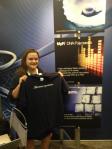
American Society of Human Genetics 2012 Annual Meeting
Bioline was once again an exhibitor (#Booth 1324-1326) at the American Society of Human Genetics (ASHG) annual meeting held in San Francisco in November. The largest human genetics meeting in the world, ASHG 2012 attracted over 7000 delegates to discuss the very latest advances in basic and clinical research.
Sessions included topics such as comparative epigenomics, early exome sequencing in complex traits, large-scale identification of regulators of translation and integrated genetic and functional studies of disease-causing variants.

Bioline USA at ASHG 2012
Bioline unveiled its new format exhibition stand at the conference, where our representatives met with scientists and discussed solutions to their molecular biology challenges. Bioline PCR Specialist, Dr. Sven Bocklandt gave a series of well received and thought-provoking talks on some of our latest products, including SensiFAST™, MyFi™ and MyTaq™ DNA polymerases. Exciting results from both published papers and some unpublished experiments from the Bioline scientific community were presented, including results from the Bioline PCR Challenge.
In keeping with ASHG 2012, this month’s Bioline scholar is dedicated to Human Genetics. We are pleased to highlight a selection of recent papers featuring Bioline products, perfectly suited for both small- and large-scale genetic and genomic studies in humans.
BIO-X-ACT™ Long DNA Polymerase
Mutations in MTM1 (myotubularin 1) cause X-linked myotubular myopathy that affects 1 in 50,000 males. In neonates or infants, movement and breathing are severely affected. The authors developed a MTM1-specific database of genetic variants, with 474 identified mutations from 472 patients. Next-Gen sequencing (Illumina HiSeq) and cDNA analysis revealed the presence of a novel MTM1/MAMLD1 fusion transcript in one case.
Oliveira, J. et al. (2012). Expanding the MTM1 mutational spectrum: novel variants including the first multi-exonic duplication and development of a locus-specific database. Eur. J. Hum. Genet. doi: 10.1038/ejhg.2012.201
cDNA synthesis kit
Children with X-linked retinitis pigmentosa (XLRP) often go blind by the second decade of life. A severe form of XLRP, RP23, was previously mapped to a 10.71Mb interval on Xp22.31-22.13, containing 62 genes. Using targeted NGS (Illumina), the authors identified a deep intronic mutation in OFD1 as the most likely cause of RP23. Insertion of a cryptic exon produces an aberrant transcript and reduced levels of correctly spliced transcript. This is predicted to result in a severely truncated protein and decreased levels of normal protein.
Webb, T.R. et al. (2012). Deep intronic mutation in OFD1, identified by targeted genomic next-generation sequencing, causes a severe form of X-linked retinitis pigmentosa (RP23). Hum. Mol. Genet. 21(16):3647-3654.
BIOTAQ™ DNA Polymerase
The genetic basis for susceptibility to malaria in a Vietnamese population was investigated by SNP genotyping by researchers from Oxford University and the MalariaGen consortium. Data from 65 SNPs in 42 malarial candidate genes in 956 severe malaria cases and 2350 controls from Vietnam was reported. Variants in six genes (ICAM1, IL1A, IL17RC, IL13, LTA and TNF) encoding adhesion and pro-inflammatory molecules were associated with severe malaria.
Dunstan, S.J. et al. (2012). Variation in human genes encoding adhesion and proinflammatory molecules are associated with severe malaria in the Vietnamese. Genes Immun. 13(6):503-508.
BioMix™ Red
Facioscapulohumeral muscular dystrophy (FSHD), characterized by muscle weakness and wasting, is associated with a shortened telomeric chr 4q35 due to deletions of the D4Z4 tandem repeat (FSHD1) or DNA methylation changes of D4Z4 (FSHD2). Using exome sequencing (Illumina NGS) the authors identified two known pathogenic mutations in CAPN3, indicating a case of limb-girdle muscular dystrophy type 2A (LGMD2A) rather than FSHD2. The authors conclude that ‘diagnosis by sequencing’ of FSHD may be more commonly adopted in clinical genetics laboratories around the world.
Leidenroth, A. et al. (2012). Diagnosis by sequencing: correction of misdiagnosis from FSHD2 to LGMD2A by whole-exome analysis. Eur. J. Hum. Genet. 20(9):999-1003
An arrayed human genomic library comprising 115,000 PAC clones was constructed. Functional studies with a p53-containing PAC clone in p53-null human osteosarcoma cells showed the utility of individual library members in human cell culture models. The library can be used to validate candidate genes identified by GWAS and for gene therapy in different recessive disorders.
Fuesler, J. et al. (2012). An arrayed human genomic library constructed in the PAC shuttle vector pJCPAC-Mam2 for genome-wide association studies and gene therapy. Gene. 496(2):103-109
Immomix™
Charcot-Marie-Tooth disease (CMT) is an inherited disorder of peripheral nerve dysfunction resulting in numbness and weakness. Mutations in four genes encoding an aminoacyl-tRNA synthetase (ARS) have been associated with CMT. This study from the University of Michigan found that the p.Arg329 AARS mutation is a recurrent, loss-of-function mutation that arises due to methylation-mediated deamination of a CpG dinucleotide.
McLaughlin, H.M. et al. (2012). A Recurrent loss-of-function alanyl-tRNA synthetase (AARS) mutation in patients with charcot-marie-tooth disease type 2N (CMT2N) Hum. Mutat. 33(1):244-253
Introducing the Bioline Scholar Publications Database
If you’re interested in knowing more about the fields and areas of research in which Bioline products have been used to further knowledge, we’ve added a Bioline Scholar page to our web site listing the papers and publications in which our molecular biology reagents are featured.
You can search for publications by author, title, topic and product and the archive contains papers from 1994 through to the present. Currently the Bioline Scholar database lists and provides links to publications where the research was conducted using the following Bioline products:
- VELOCITY DNA Polymerase
- BIOTAQ™ DNA Polymerase
- SensiMix II Probe Kit
- MyTaq™ DNA Polymerase
- MyTaq™ Red DNA Polymerase
- MyTaq™ Mix
- MyTaq™ Red Mix
- MyTaq™ HS DNA Polymerase
- MyTaq™ HS Mix
- SensiFAST™ SYBR & Fluorescein One-Step Kit
- SensiFAST™ SYBR Hi-ROX One-Step Kit
- SensiFAST™ SYBR No-ROX One-Step Kit
- SensiFAST™ Probe No-ROX One-Step Kit
- SensiFAST™ SYBR & Fluorescein Kit
- SensiFAST™ SYBR Hi-ROX Kit
- SensiFAST™ SYBR Lo-ROX Kit
- SensiFAST™ SYBR No-ROX Kit
- SensiFAST™ Probe No-ROX Kit
- SensiMix SYBR Hi-ROX Kit
- SensiMix SYBR & Fluorescein One-Step Kit
- SensiMix SYBR & Fluorescein Kit
- SensiMix Probe One-Step Kit
- SensiMix HRM Kit
- SensiMix Capillary One-Step Kit
That’s it for the Bioline blog in 2012—season’s greetings to all our customers and readers alike, from all at Bioline—see you in 2013!

